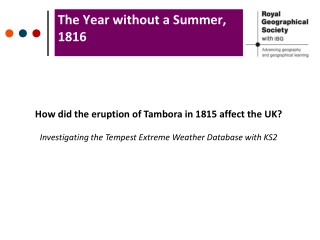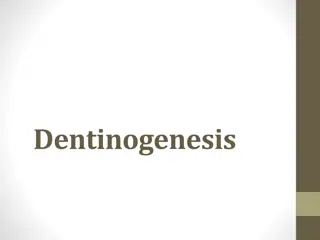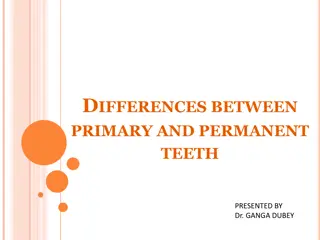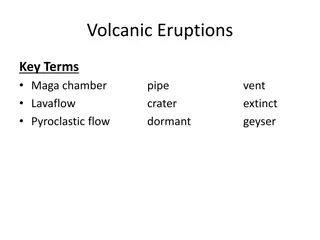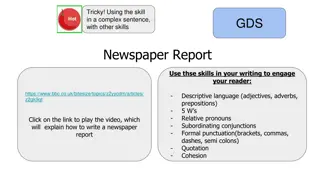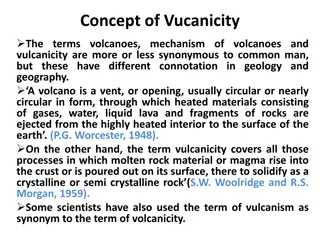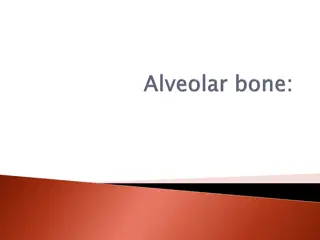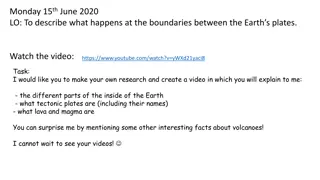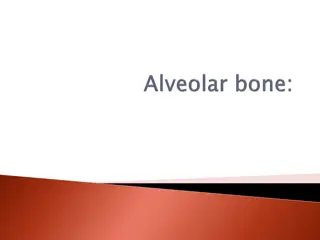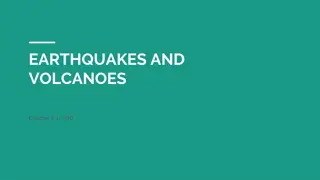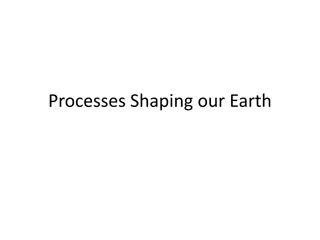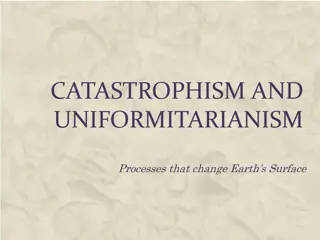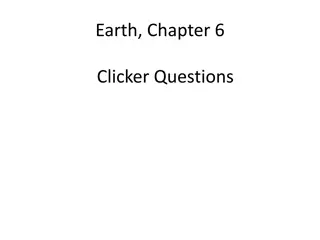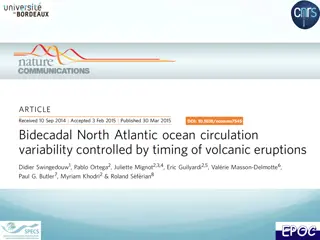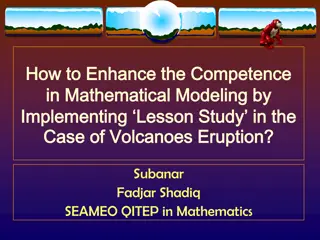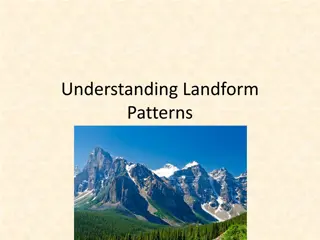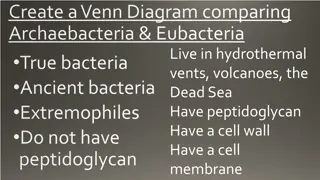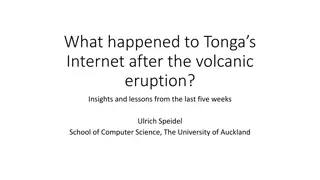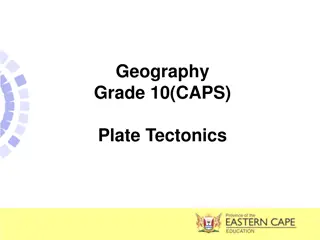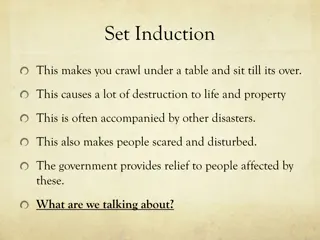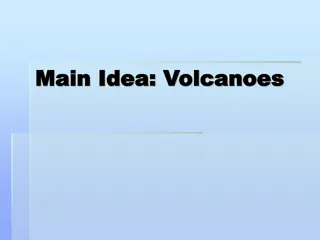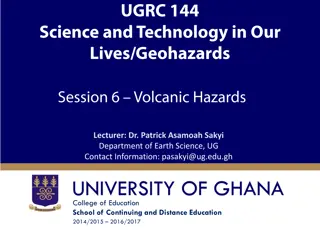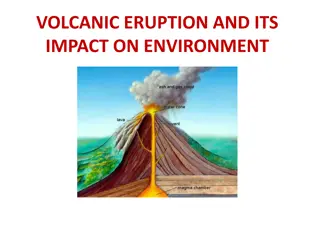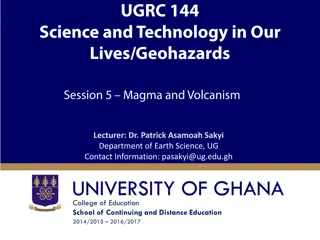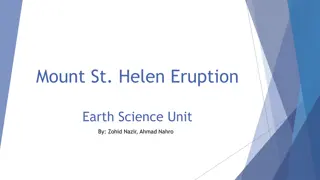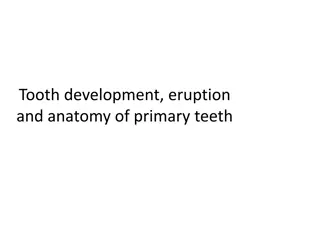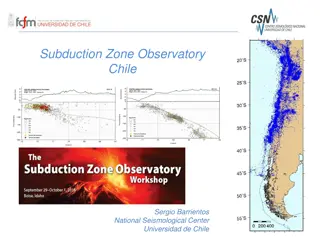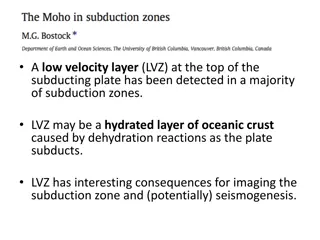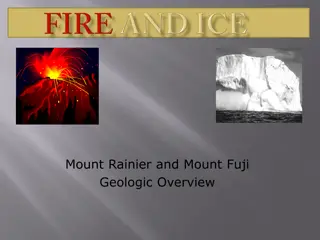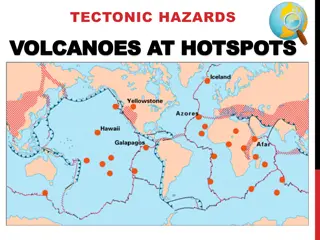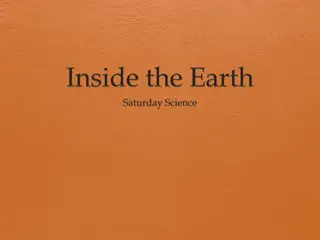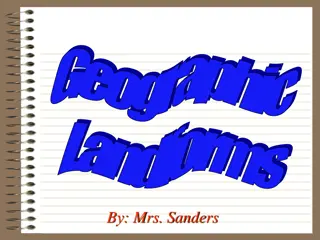The Year without a Summer, 1816
The eruption of Mount Tambora in 1815 affected global temperatures, leading to the infamous Year Without a Summer in 1816. Investigate the implications of this historical event using the Tempest Extreme Weather Database with KS2.
1 views • 4 slides
Understanding Dentinogenesis: A Comprehensive Overview
Dentinogenesis is a crucial process in tooth development starting at the cusp tips as odontoblasts differentiate and begin collagen production. Factors like TGF, IGF, and BMP play key roles in organizing odontoblast cytoskeleton assembly. Odontoblasts take up calcium, maintain high concentrations, a
0 views • 38 slides
Geology Unit Review
This geology unit review covers identifying different processes such as uplift, subduction, and convection, as well as types of volcanoes like cinder cones and composite volcanoes. It also discusses the Pacific Plate and its unique characteristics, along with volcanic activity around the Ring of Fir
2 views • 9 slides
Understanding the Development of Occlusion and Dentition
Exploring the stages of tooth development, eruption, theories, and keys to normal occlusion. Learn about primary and permanent dentition, dental formulae, dental lamina, odontogenic cells, and enamel organ formation in the process of tooth development.
6 views • 108 slides
Understanding the Relationship Between Intangible Cultural Heritage and Disaster Risk Reduction
This PowerPoint presentation by UNESCO explores the connection between Intangible Cultural Heritage (ICH) and Disaster Risk Reduction (DRR). It covers key concepts like disasters, risks, vulnerabilities, and resilience, emphasizing the importance of safeguarding and mobilizing ICH in the face of dis
7 views • 23 slides
Differences Between Primary and Permanent Teeth Explained
Dive into the distinctions between primary (baby) and permanent teeth presented by Dr. Ganga Dubey. Explore general variances, eruption sequences, crown characteristics, and histological differences. Understand individual variations in tooth morphology for a comprehensive comparison.
0 views • 39 slides
Understanding Volcanic Eruptions: Key Terminology and Processes
Volcanic eruptions are caused by the release of pressure inside the Earth, leading to the expulsion of magma through volcanic vents. This process results in the formation of cone-shaped mountains or hills known as volcanoes. The magma, which originates from the asthenosphere, rises through cracks in
1 views • 24 slides
Tragic Tale of Pompeii: Volcanic Eruption and Stone
Ancient Pompeii faced a catastrophic fate when Mount Vesuvius erupted violently, wiping out the entire town and turning residents into stone. Learn about this eerie event through a detailed newspaper report, capturing the fear and devastation that engulfed the once-thriving city.
1 views • 12 slides
Understanding Volcanoes: Mechanisms and Vulcanicity
Volcanoes, mechanisms of eruption, and vulcanicity are explored in geology and geography. Learn about volcanic vent characteristics, types of volcanoes, and classifications based on eruption modes. Vulcanicity encompasses processes involving magma ascent and surface appearance.
0 views • 16 slides
Understanding the Role of Alveolar Process in Dental Development
The alveolar process in the upper and lower jaw plays a vital role in housing, supporting, and protecting teeth. It anchors tooth roots, facilitates tooth movement for proper occlusion, absorbs and distributes occlusal forces, supplies vessels to the periodontal ligament, and aids in tooth eruption.
1 views • 28 slides
Exploring the Forces of Nature: Volcanoes and Tectonic Plates
Embark on a journey to uncover the mysteries of the Earth's inner workings by delving into the dynamics of tectonic plates, magma, and lava. Discover the marvels of volcanoes, from their key features to the impact of volcanic eruptions on both the environment and people. Engage in creative tasks lik
0 views • 10 slides
Structure and Functions of the Alveolar Process in Jaw Anatomy
The alveolar process in the upper and lower jaw is responsible for housing the roots of teeth, supporting tooth eruption, providing attachment for facial muscles, and aiding in mastication. During fetal development, the alveolar process forms and separates tooth germs, leading to the differentiation
3 views • 26 slides
Understanding Earthquakes and Volcanoes: a Comprehensive Overview
Earthquakes are vibrations in the ground caused by movement along faults in the Earth's lithosphere. They occur mostly near plate boundaries and are difficult to predict. Different types of faults and seismic waves play a crucial role in understanding these natural phenomena. Seismologists study ear
0 views • 19 slides
Understanding Processes Shaping Earth: Lithosphere, Plate Tectonics, and Effects
Explore the components of our planet, such as the lithosphere, hydrosphere, atmosphere, and biosphere. Learn how the lithosphere, consisting of the Earth's crust and top solid mantle, interacts through plate tectonics, causing movements that shape the Earth's surface. Discover the concept of Pangaea
0 views • 31 slides
Earth's Surface Evolution: Catastrophism vs. Uniformitarianism
Catastrophism and uniformitarianism are two contrasting processes that have shaped Earth's surface over time. Catastrophism involves sudden, violent events like volcanoes and earthquakes, while uniformitarianism relies on gradual processes such as erosion. Geologists study these processes to underst
4 views • 13 slides
Understanding Earth's Geology: Chapter 6 Clicker Questions
Chapter 6 of the Earth's geology covers various topics including the melting associated with the addition of carbon dioxide or water to rocks, types of magma based on silica content, descriptions of hot mafic magma, and characteristics of pyroclastic flows in volcanoes. Test your knowledge with thes
0 views • 11 slides
Visualizing Relationships with Data: Earthquakes, Volcanoes, and Plate Tectonics
Explore the locations of earthquakes and volcanoes to understand plate boundary zones, compare plate motion in different regions, and determine plate boundary zones using various data sources. Follow step-by-step instructions to study maps, analyze earthquake and volcano distributions, and engage in
0 views • 37 slides
Comprehensive AP Environmental Science Study Guide
Covering a wide range of topics including Earth Systems and Resources, The Living World, Population, Land and Water Use, Energy Resources and Consumption, Pollution, and Global Change, this study guide provides detailed information on geologic time scales, plate tectonics, atmospheric composition, w
0 views • 168 slides
Understanding Atlantic Overturning Observed and Simulated Variability
Exploring the initiation of the Atlantic overturning using observations and simulation reconstructions with models. Analysis of historical agreement, synchronisation, and control simulations. Investigation of a 20-year cycle in sea ice cover, feedback mechanisms, and the impact of events like the Mt
0 views • 32 slides
Enhancing Competence in Mathematical Modeling Through Lesson Study: Focus on Volcanoes Eruption
Implementing Lesson Study in math education can enhance competence in mathematical modeling, as demonstrated in the case of volcanic eruptions. The shift to student-centered learning in the 2013 Indonesian curriculum aims to cultivate independent learners and responsible citizens, aligning with the
0 views • 27 slides
Educational Lesson on Bearings and Navigation for Students
Students will apply their knowledge of bearings to a real-world navigation scenario, including measuring and constructing bearings, and calculating distances using scale. The lesson is part of a series focused on Mysteries of the Deep Earth, specifically planning a research voyage to Australia's und
0 views • 21 slides
Unveiling Earth's Landform Patterns Through History
Explore the fascinating journey of Earth's landforms, from the formation of continents to the theory of Plate Tectonics. Delve into the rich history of geology, uncovering insights from notable scientists like James Hutton and Alfred Wegener. Witness the dynamic processes of earthquakes, volcanoes,
0 views • 52 slides
Comparison of Archaebacteria & Eubacteria Venn Diagram
Archaebacteria and Eubacteria are two types of bacteria with distinct characteristics. Archaebacteria are ancient bacteria that are extremophiles, living in harsh environments like hydrothermal vents and volcanoes, lacking peptidoglycan. On the other hand, Eubacteria are true bacteria with peptidogl
0 views • 60 slides
Insights on Tonga's Internet Situation Post-Volcanic Eruption
Following the volcanic eruption in Tonga, disruptions in the internet connectivity were observed, with cables failing and challenges in utilizing satellite capacity. The potential of Starlink to assist was explored, revealing obstacles like signal impairment due to the volcanic ash and satellite pos
0 views • 25 slides
Year Four Information for Parents
The Year Four team is excited to welcome your children to their new learning environment. Transition activities include meeting the new teachers, learning about Year 4 highlights, and setting goals for a successful year. Parents are encouraged to support their child's learning at home, especially in
0 views • 14 slides
Understanding Plate Tectonics and Earth's Surface Features
The study of plate tectonics reveals how the Earth's crust is divided into tectonic plates, leading to various types of plate boundaries like divergent, convergent, and transform. These movements result in earthquakes, volcanic eruptions, and landform changes such as folding and faulting. Different
0 views • 15 slides
Understanding Earthquakes and Plate Tectonics
Rapid Earth Movement, specifically earthquakes, is a natural disaster causing destruction and fear. Plate tectonics play a crucial role in the occurrence of earthquakes and volcanoes. The movement of Earth's plates at plate boundaries results in different geological features like fold mountains. Thi
0 views • 36 slides
Understanding Volcanoes: Structure, Caldera Formation, and Characteristics
Volcanoes are geological formations with vents, craters, and slopes. The structure of a volcano includes a vent for lava emission and a crater connected to a magma chamber. Understanding the difference between a caldera and a crater is crucial - calderas are much larger, around 50 km in diameter, fo
0 views • 5 slides
Understanding Volcanic Hazards: Session Overview by Dr. Patrick Asamoah Sakyi
This session by Dr. Patrick Asamoah Sakyi introduces students to the hazards associated with volcanoes, covering topics such as volcanic eruption components, primary and secondary effects of volcanic hazards, beneficial aspects of volcanism, and predicting volcanic eruptions. The session also includ
0 views • 35 slides
Understanding the Impact of Volcanic Eruptions on the Environment
Explore the causes of volcanic eruptions, including pressure changes, radioactive minerals, plate tectonics, hot spots, earth movement, thermal contraction, and water's role. Learn about different types of volcanicity and the landforms created by both extrusive and intrusive volcanic activity, from
0 views • 20 slides
Understanding Volcanic Processes and Magma Formation with Dr. Patrick Asamoah Sakyi
Explore the dynamics of volcanic eruptions, magma formation, and volcanic materials in this session led by Dr. Patrick Asamoah Sakyi from the Department of Earth Science at UG. Delve into topics such as magma origins, lava composition, factors influencing volcanic eruptions, volcano classification,
0 views • 41 slides
Mount St. Helen Eruption: A Earth Science Study
Explore the devastating eruption of Mount St. Helen in 1980 through before, during, and after phases. Witness the impact on the environment, wildlife, and communities as well as the geological and meteorological connections revealed during the event.
0 views • 11 slides
The Science Behind Coke and Mentos Eruption Revealed
Understanding why Coke erupts when you add Mentos involves the unique ingredients present in both, leading to a fascinating chemical reaction. Different ingredients in Coke, Coke Zero, and Diet Coke result in varying levels of eruption intensity. This experiment by Liv and Sam aims to demonstrate th
0 views • 9 slides
Understanding Primary Tooth Development and Eruption
Explore the stages of tooth development and eruption in primary teeth, from induction to eruption, with details on mineralization, eruption times, symptoms, disturbances, and primary dentition characteristics. Learn about common issues and the relationship between primary teeth and permanent teeth.
0 views • 12 slides
Monitoring Chile's Geological and Volcanic Activity: Subduction Zone Observatory and IPOC Network
Chile's Subduction Zone Observatory, led by Sergio Barrientos at the National Seismological Center, University of Chile, focuses on observing seismic and geological events with cutting-edge technology and networks. The IPOC Chile Volcanological Network monitors around 40 volcanoes, utilizing various
0 views • 4 slides
Understanding the Low Velocity Layer (LVZ) in Subduction Zones
The presence of a Low Velocity Layer (LVZ) at the top of subducting plates in subduction zones has significant implications for imaging and potentially seismogenesis. This hydrated layer of oceanic crust, likely caused by dehydration reactions during subduction, affects seismic wave behaviors and ca
0 views • 12 slides
A Comparative Study of Mount Rainier and Mount Fuji
Mount Rainier and Mount Fuji are two geologically significant volcanoes, both born of fire but shaped differently by the forces of nature. Mount Rainier, located in Washington, USA, is a young volcano eroded by glaciers, while Mount Fuji in Japan remains conically shaped due to minimal glacial erosi
0 views • 16 slides
Exploring Volcanoes and Hotspots: A Geological Adventure
Delve into the world of volcanoes and hotspots in this educational content, uncovering the mysteries of how these geological features form and behave. From extinct volcanoes to the movement of tectonic plates, journey through fascinating concepts with informative visuals and engaging activities.
0 views • 9 slides
Journey to the Earth's Layers
The Earth's structure consists of four main layers: the crust, mantle, outer core, and inner core. The crust is the thin, rocky layer we see on the surface, while the mantle is a solid layer that flows like a viscous liquid. The outer core is a hot, melted layer of iron and nickel, and the inner cor
0 views • 10 slides
Exploring Geographic Features: From Oceans to Volcanoes
Discover the diverse range of geographic features, from vast oceans and intricate coral reefs to winding rivers and dense forests. Learn about intriguing formations like peninsulas, isthmuses, and straits, and delve into natural wonders like sinkholes and wetlands. From coastal regions to volcanic l
0 views • 29 slides
